The atmospheric emissions associated with the biogas produced in landfills have particular effects on air quality since, in addition to local problems deriving from the presence of bad-smelling trace components, methane CH4 and carbon dioxide CO2, as the main constituents of the biogas itself, have important implications in alteration phenomena on a global scale. In addition to this, we must consider the fact that biogas can also represent risks linked, for example, to fire and explosion, asphyxiation and poisoning as well as phytotoxicity and the synergy of all these effects.
Where combustion activities play a predominant role in CO2 emissions, fugitive emissions of methane CH4 from landfills can represent a significant contribution to climate change phenomena, by virtue of the significant global warming potential that characterizes them and that corresponds to 28 times that of carbon dioxide as reported in the fifth and last assessment report from the IPPC, issued in 2014 and called AR5 (https://www.ghgprotocol.org/sites/default/files/ghgp/Global-Warming-Potential-Values%20%28Feb%2016%202016%29_1.pdf)
The most up-to-date data from the Italian national inventory of emissions (Annuario dei dati ambientali 2019 – Annual Environmental Data Report 2019, 89/2020, ISPRA – Table 7.4 and Figure 7.4.b) identify landfills as the second largest source of atmospheric methane emissions, with a contribution equal to almost one third of all the sources identified (https://www.isprambiente.gov.it/files2020/pubblicazioni/stato-ambiente/annuario-2020/07Atmosfera2019.pdf)




